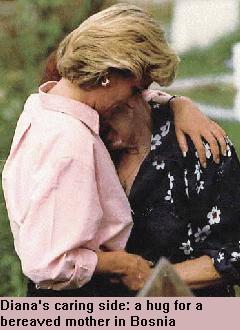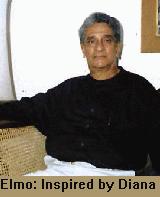

![]()
 Bosnia
may not be hitting the front pages much any more but still it is not a safe
place to visit - yet this did not deter Diana, Princess of Wales when she
decided to carry her crusade against landmines to the former Yugoslavia last
month.
Bosnia
may not be hitting the front pages much any more but still it is not a safe
place to visit - yet this did not deter Diana, Princess of Wales when she
decided to carry her crusade against landmines to the former Yugoslavia last
month.
She had been planning the trip for months and was determined to go, even after the British Red Cross warned her that it was inadvisable. She was hoping to get the cause a lot of press coverage. But, as the world now knows, it didn’t work out that way. The impact of her three-day visit was sharply reduced by reports of her romance with Harrods heir Dodi Fayed. The shattered cities of war-ravaged Yugoslavia filled fewer column inches than luxury yachts and romantic holidays with a playboy millionaire.
Diana had flown to Sarajevo aboard billionaire George Soros’ private jet, only to be greeted by almost 100 journalists waiting on the tarmac hoping for an update on her romance. And on her flight home, as she studied newspaper photographs of her cruise around Sardinia with Dodi, the Princess grew exceedingly angry as she was forced to realise that a few moments indiscretion had cost her campaign a great deal of publicity.
Alongside the journalists waiting to greet Diana in Sarajevo was the man who first persuaded her to visit the country - Ken Rutherford, a co-founder of the Landmines Surviors Network, who lost both his legs to a landmine in Somalia. Beside him stood British ambassador Charles Crawford, whose presence clearly indicated that the Government was actively backing Diana’s landmines campaign. During her visit, Diana remained totally focused on her objective - to highlight the plight of landmine victims. Unfortunately, the press following her had other priorities. In Tuzla, one reporter asked her: "What is the situation with Dodi?" But to all such questions, her only reply was an icy glare.
Diana’s mind was clearly only on her humanitarian work. While in the once beautiful city of Sarajevo, the Princess ordered her van to stop so she could take a close look at the ruined buildings. "I have seen lots of poverty before but I have never seen such devastation," she said.
On her first day, she visited landmine victims and their families in Tuzla. The next morning she rose early to continue her work travelling across most of northern Bosnia. Many of those she met did not know who she was. One victim’s mother admitted she had never heard of Diana, then said she was amazed by the number of photographers swarming around her. When a tall, tanned and glamorous princess turned up at the home of Mohamed Soljankic, she made his day. In broken English he told her: "The only way I can express my feelings is to say to you I am pleased, Lady Diana."
Her next stop was the home of 14 year -old Muslim Malic Bradoric in Klokatnica. He was collecting wood when a mine blew off his left foot and damaged his right. Now he is walking again with a prosthesis given to him by Norwegian People’s Aid.
Her last day was the most harrowing. Back in Sarajevo, she stopped as she passed one of the city’s overflowing cemeteries, after noticing a mother tending the grave of her soldier son, Dragan Tadic. The Princess tried to speak to Elvira Tadic, then, bypassing the language barrier, she put her arms around her in a gesture that said far more than words.
Another emotional encounter came soon afterwards when Diana visited the poverty-stricken home of Mirzeta Gabelic, a 15-year-old who lost a leg last year. She listened intently as Mirzeta,nervously chewing gum, told her story.
Back home the newspapers were still packed with those photographs, making the Princess aware that her fame could be a double-edged sword.
But as she left Sarajevo after a snatched lunch, her hosts were pleading with her to join them at a major international conference on landmines to be held in Oslo in September.
 Lankan
ornitholo gist Elmo Alles has plans to launch a campaign to educate his
countrymen of the disastrous effects of landmines, a cause very close to his
heart.. Inspired by the commitment and seriousness of purpose evident in the
humanitarian work undertaken by Princess Diana, he recently wrote to her
seeking guidelines on effective campaigning.
Lankan
ornitholo gist Elmo Alles has plans to launch a campaign to educate his
countrymen of the disastrous effects of landmines, a cause very close to his
heart.. Inspired by the commitment and seriousness of purpose evident in the
humanitarian work undertaken by Princess Diana, he recently wrote to her
seeking guidelines on effective campaigning.
An inspirational letter was promptly sent to him by the Kensington Palace office of the Princess of Wales. With the untimely death last Sunday of the world’s most photographed woman who became a crusader in her own right, Elmo now has to satisfy himself by merely studying the Princess’ style of campaigning, and continuing it as a tribute to the humane Royal who tirelessly worked to achieve her goal of banning landmines some day.
In November 1993, Elmo was at Eardley Crescent in London. He had many ornithological pursuits in mind, and it was partly for this purpose that he was in London. Next to the apartment he was occupying was an inconspicuous AIDS Counselling Centre. It was here that he had his only encounter with the Princess.
"The only possible indication of VIP presence was a police constable at the apartment door and the Lady Mayoress who stood by. Then the door opened. Princess Diana walked out to speak and shake hands with bystanders with the easy warmth she always exuded. She was the typical fairytale princess come alive," he recalls.
"My first thought was of a porcelain doll with the capacity to light up a place only with a smile, a gesture," enthused Elmo, who said that perhaps Diana’s aura was the result of the glow of her generous spirit.
Initially, Elmo says he had misgivings about Diana’s commitment to her charity work. It appeared to be escapism from an unhappy marriage, the rigidity of Buckingham Palace and social and media pressure. But as she threw her full weight behind her various charity projects, it appeared that she was genuinely committed, and wanted to change the world for the better.
Inspired by the intensity of her anti landmines campaign, he wrote to the Princess of Wales in May 1997 inviting her to help launch a similar campaign in Sri Lanka to educate the public on the dangers of landmines to noncombatants.
He invited her to visit the country, and enclosed a brochure which promoted local tea as a health drink. Elmo received a reply on June 17 , 1997 expressing the Princess’ best wishes for the work he was doing for the Ranaviru Sevena. The letter also instructed him to contact the local Red Cross for assistance.
Elmo was planning to visit London again this year. He had plans to meet the Princess, and learn from her experiences of landmines.
An ornithologist by profession, Elmo recently began helping the socially and physically handicapped, and commenced a programme of hydro therapy treatment at the Ragama Ranaviru Sevena, a home for the disabled soldiers.
Elmo points out that the issue of landmine activity has never been properly discussed. In addition to the scars and the disabilities the victims also become psychologically disturbed. Landmine victims have a reduced span of concentration due to their extremely traumatic experiences. So he introduced occupational therapy with a difference, hydrotherapy coupled with bird watching to the inmates of the Ranaviru Sevena.
Elmo Alles stresses upon the necessity of taking into account the large numbers of noncombatants apart from the combatants who have become victims of landmines.
Continue to Plus page 6 - Dodi offered Di a different family
Return to the Plus contents page
![]()
| HOME PAGE | FRONT PAGE | EDITORIAL/OPINION | NEWS / COMMENT | BUSINESS
Please send your comments and suggestions on this web site to
info@suntimes.is.lk or to
webmaster@infolabs.is.lk